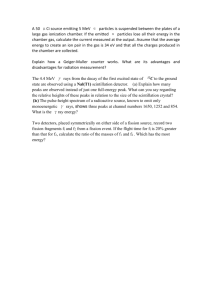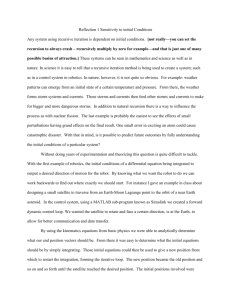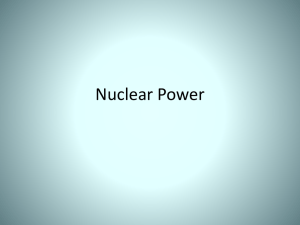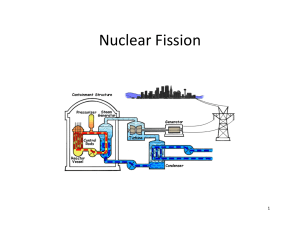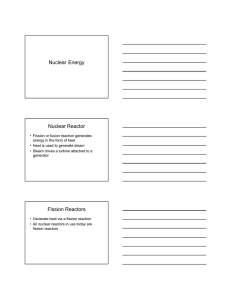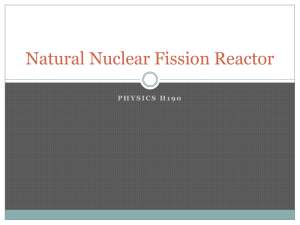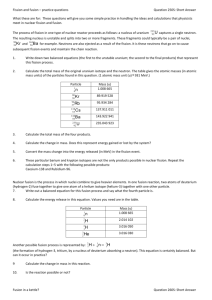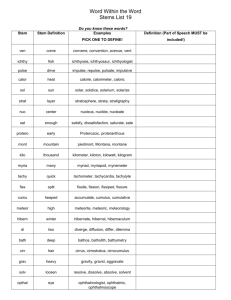TAP 528-2: Fission in a nuclear reactor – how the mass changes
advertisement
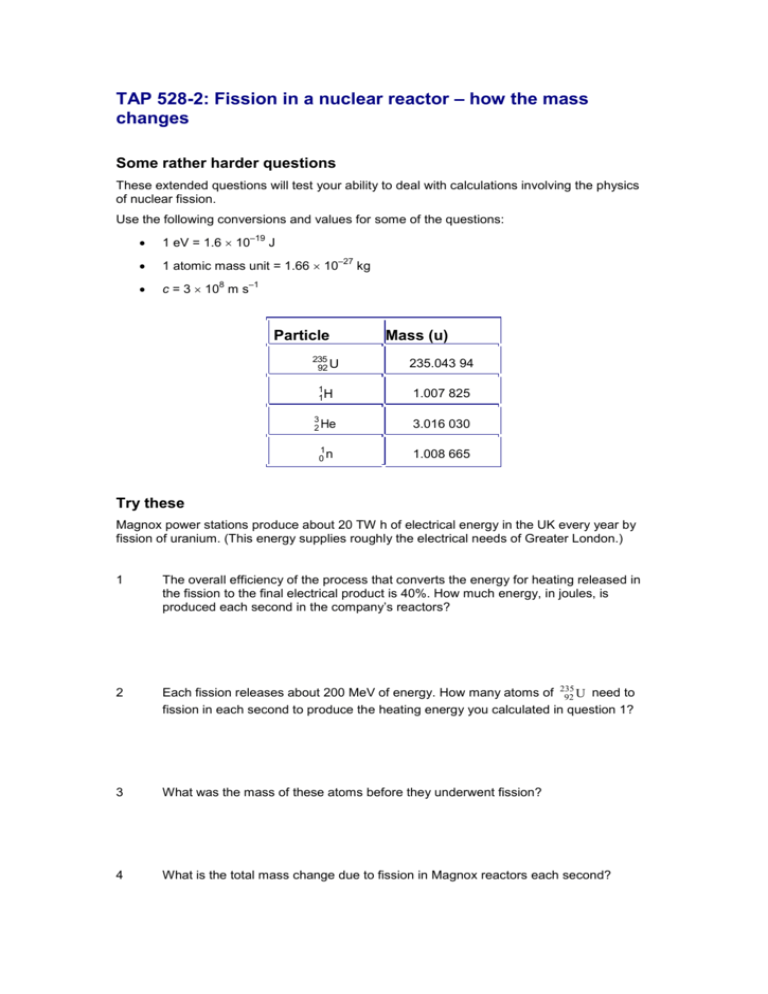
TAP 528-2: Fission in a nuclear reactor – how the mass changes Some rather harder questions These extended questions will test your ability to deal with calculations involving the physics of nuclear fission. Use the following conversions and values for some of the questions: –19 1 eV = 1.6 10 1 atomic mass unit = 1.66 10 J –27 8 c = 3 10 m s kg –1 Particle Mass (u) 235 92 U 235.043 94 1 1H 1.007 825 3 2 He 3.016 030 1 0n 1.008 665 Try these Magnox power stations produce about 20 TW h of electrical energy in the UK every year by fission of uranium. (This energy supplies roughly the electrical needs of Greater London.) 1 The overall efficiency of the process that converts the energy for heating released in the fission to the final electrical product is 40%. How much energy, in joules, is produced each second in the company’s reactors? 2 Each fission releases about 200 MeV of energy. How many atoms of 235 92 U need to fission in each second to produce the heating energy you calculated in question 1? 3 What was the mass of these atoms before they underwent fission? 4 What is the total mass change due to fission in Magnox reactors each second? In the pressurised water reactor (PWR) the fuel rods do not contain pure 235 92 U . The uranium comes from mined ore that contains a mixture of 238 92 U and 235 92 U . The fuel delivered to the reactor contains 0.7% of 235 92 U . The fuel rod stays in the reactor for about 3 years and is then removed to allow reprocessing. This time consider just one reactor with an output of 1 GW. 5 Calculate the number of uranium nuclei disintegrating every second. 6 Calculate the mass of 7 Estimate the mass of 8 Estimate the total mass of both uranium isotopes required in the core for a 3 year cycle. 9 Is your estimate in question 8 likely to be an upper or a lower limit? 235 92 U 235 92 U that undergoes fission every second. required in the core for a 3 year cycle. Hints 1 Remember the meaning of the term watt-hour. It corresponds to the amount of energy delivered at a rate of 1 joule per second for 1 hour. Do not forget to include the efficiency in your calculation. 2 Convert to J from MeV. 3 Use the nucleon number of the uranium and the conversion from atomic mass units to kilograms. 4 Use E = mc2 to calculate this. 7 The information indicates that one-third of the fuel needs to be removed for reprocessing every year. Your answer to question 6 can be multiplied up to give the fuel usage in 1 year. This is one-third of the total. 8 The answer to question 7 represents the fuel used, and this is 3% of all the uranium (both isotopes). Hence the total mass. Practical advice These questions revise basic conversions between electron volts and joules and atomic mass units and kilograms. Students will need to be familiar with gigawatts (GW) and terawatts (TW) in powers of 10. The questions could be extended either verbally or in writing to ask students about the volume of uranium inside the core and about the equivalent volumes of coal or oil that might be required in a conventional power station. For example, 1 megatonne of coal is equivalent to 29 x 1015 J, 1 megatonne of oil is equivalent to 42 x 1015 J. Social and human context The questions provide an opportunity for debate about fission power generation. Answers and worked solutions –1 12 7 19 1. energy = ((20 10 Wh × 3600 J W h ) / (3.16 10 )) × (100 / 40) = 5.7 10 every second. 2. number of atoms = (5.7 10 atoms. 3. mass per second = 1.8 10 19 26 7.0 × 10 –5 kg s 19 –1 mass change = (5.7 10 5. disintegrations per second = 19 6. –1 kg s –27 –1 kg u = –1 8 2 6 J s )/ (200 10 MeV × 1.6 10 26 3.0 × 10 26 J s )/ ((3 10 ) kg s ) = about 5 g mass per second = 7.8 10 –5 –1 s × 235.04394 u × 1.66 × 10 –1 JeV ) = 1.8 10 –1 4. ((1 10 –19 6 J) / (200 10 eV × 1.6 10 J –19 –1 19 –1 J eV )) × (100/40) = 7.8 10 s –1 –27 s × 235.04394 u × 1.66 × 10 –1 –5 kg s –1 7. mass = 3.0 × 10 8. mass = 2800 kg × (100/0.7) = 400 000 kg 9. Lower limit. 7 –1 × 3 years × 3.2 × 10 sy = 2900 kg External reference This activity is taken from Advancing Physics chapter 18, 270S –1 kg u =

